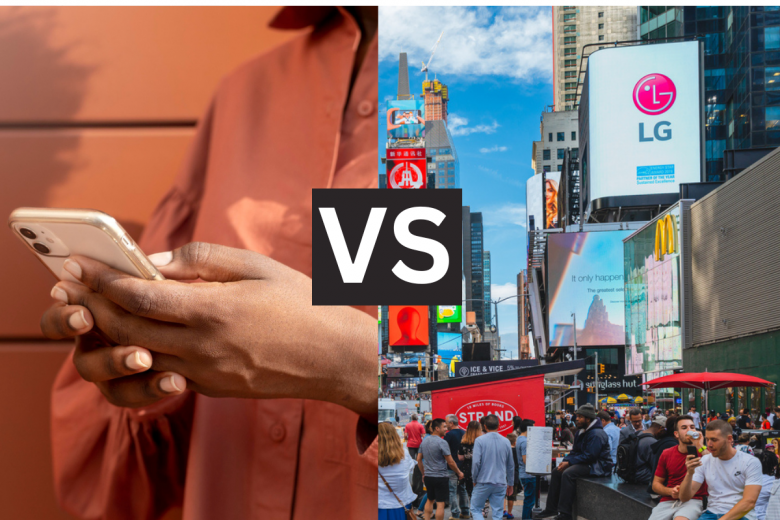Deciding on a marketing strategy for your business model all depends on your product, your demographic, and what will best suit you and/or your team. If you’re breaking into apps and the world of online businesses, then maybe you need to take a closer look at mobile marketing.
If a nomadic style of marketing in the form of a smartphone doesn’t appeal to you, then go with good, old-fashioned traditional marketing. It has worked for centuries prior, and it still works in our day and age now. But before you make a decision on which route to take for your business model, read about the pros and cons of both strategies.
Mobile Marketing
Many people tend to assume mobile marketing and digital marketing are the same. Although very similar, there is a difference between mobile marketing and digital marketing.
Mobile marketing is the promotion of products or services to consumers through mobile devices such as smartphones, tablets, and other portable electronic devices. It is a type of digital marketing that targets users on the go who use their mobile devices to access the internet.
There are several types of mobile marketing strategies to choose from. Mobile-friendly websites, mobile apps, SMS or MMS messaging, push notifications, and mobile search ads just to name a few. The goal of mobile marketing is to reach consumers in a way that is relevant, timely, and convenient for them. This way, mobile marketing also generates leads and drives sales for businesses by reaching a demographic of people constantly moving.
There are several advantages of mobile marketing in the 21st century. It has become integral to marketing strategies everywhere. This is due to the growing use of mobile devices and the increasing reliance on mobile technology for everyday tasks.
It has allowed businesses to connect with their target audience in real-time and engage them in a more personalized and interactive way. For example, by knowing a consumer’s location based on location preferences in settings on their smartphone, TripAdvisor or Yelp would be able to recommend restaurants or establishments close by. Food service delivery businesses like Ubereats or Doordash are also prominent users of location-based data from their customers.
Traditional Marketing
Traditional marketing, on the other hand, encompasses a range of marketing tactics that were popular before the advent of digital marketing. This includes print ads, television and radio commercials, billboards, direct mail, and trade shows.
The familiarity of traditional marketing can also be less wary to some. This is because most people are accustomed to print ads and billboards, and other notable signs of traditional marketing. There’s also a level of brand recognition in traditional marketing that is lost in digital marketing.
Being able to physically see a company’s brand or logo repeatedly in different formats heightens the chance of recall for that consumer at a later time. We are used to scrolling through dumps of media and information on our smartphones. This habit lessens our ability to truly comprehend what we’re looking at. Traditional marketing has always been effective at nailing brand recall because they’re physical. They don’t have to rely on consumers magically remembering that one brand name or word during the constant scrolling of feeds.
The Difference Between the Two
Traditional marketing drastically differs from modern mobile marketing, utilizing conventional advertising methods and media channels to promote products or services. Here are some prominent differences between the two.
Customer Engagement
Mobile marketing allows for more interactivity and engagement between businesses and customers. This perk is actually one of the goals of mobile marketing. Traditional marketing only has a one-way communication model with its customers. In digital and mobile marketing, customers can engage with businesses quickly and easily. This is done through mobile apps or social media. The interactions between customers help businesses because customers can provide feedback and they can receive personalized offers.
Audience Reach
Traditional marketing often casts a wide net and reaches a broad audience. Tactics like billboards and television commercials are designed to be digestible to all demographics. They are most useful when wanting to reach a large audience. There’s also tangibility when it comes to traditional marketing that isn’t available in an online forum. Being able to print and give out brochures, business cards, and flyers, allows consumers to examine the material at any time at their convenience.
Mobile marketing garners attention for its more targeted and personalized advertisements. Allowing marketers to reach specific audiences based on demographics, interests, and behavior.
Cost
Traditional marketing can be expensive, particularly for businesses with limited budgets. Mobile marketing, on the other hand, can be more affordable. Particularly, with the rise of low-cost or free mobile marketing tools.
- Billboards-In the U.S. a standard 14’ x 48’ Billboard in a metropolitan area average from approximately $2,000 to $20,000 per 4-week period according to Billups.
- Radio marketing--The cost of radio marketing can also vary depending on the location, time of day, and target audience. In general, a 30-second spot on a local radio station can cost between $200 to $5,000. A national spot on a popular radio show can cost upwards of $50,000.
- Print ads– The cost of print ads can vary depending on the publication, circulation, size of the ad, and color vs. black and white. A full-page black and white or color ad in a national magazine can range from $250,000 to $700,000.
- Television– In general, a 30-second spot during a prime-time show on a major network can cost anywhere from $50,000 to $500,000. While a spot during a less popular time slot can cost significantly less.
The cost of marketing on mobile is far less in comparison. Businesses can choose their budgets when creating a campaign based on how much they want to spend. It also depends on the type of medium the marketer chooses. For example, in the U.S., marketing videos’ cost per 1000 impressions (CPMs) is around $15.
Metrics and Analytics
Mobile marketing provides more detailed metrics and analytics compared to traditional marketing. With mobile marketing, businesses can track customer engagement, conversion rates, and other metrics in real time. This allows them to optimize their campaigns for better results.
Using visually attractive content is one of the mobile marketing best practices. In fact, it is a best practice in all forms of marketing. However, unlike traditional marketing, marketers can use analytics to monitor the impact of their ads.
Conclusion
Traditional marketing still has its place in some industries and for certain types of businesses. However, its effectiveness has been declining in recent years as consumers increasingly rely on digital channels to research products and make purchasing decisions. If you’re insistent on brand recall for your company traditional marketing may be the best route. If engagement is a key goal, digital marketing of any kind will be your best bet. It’s simply more cost-efficient to move to an online format and probably worth the audience reach.
Many businesses are shifting their focus toward digital marketing strategies that allow for more targeted and personalized communication with customers. If you can figure out a personalized message and brand that best enables your connection with your consumers in an online format, that may be the best strategy to help spur your business model forward.
Also Read:
Mobile Marketing vs Email Marketing: Understanding the Difference Between Them
Mobile Marketing vs Digital Marketing: Benefits and Drawback to them Both













Pingback: Unleashing the Power of Mobile Marketing for Your Notary Business – Notary to CEO
Pingback: Mobile Marketing Versus Traditional Marketing: A Comparison
Pingback: 6 Disadvantages of Mobile Marketing - junaidarif.live
Pingback: 6 Disadvantages of Mobile Marketing - StartUp Mindset
Pingback: 7 Key Advantages of Mobile Marketing - StartUp Mindset
Pingback: 2-1 Blog: Marketing Advantages of Mobile Phones and Tablets | Jessica Johnston
Pingback: 7 Types of Traditional Marketing Krownjobs.com - krownjobs
Pingback: Mobile Marketing vs Traditional Marketing: Which Should Businesses Choose? – Techie.Buzz
Pingback: Mobile Marketing vs Traditional Marketing: Which Should Businesses Choose? – Entrepreneur – Start, Run and Grow Your Business
Pingback: Run Your Online Enterprise Following these Cutting Edge Tactics To Make You Invincible ·
Pingback: Mobile Marketing vs Traditional Marketing: Which Should Businesses Choose? Krownjobs.com - krownjobs
Pingback: Mobile Marketing vs Traditional Marketing: Which Should Businesses Choose? | Entrepreneur Canada
Pingback: Mobile Marketing vs Traditional Marketing: Which Should Businesses Choose? – Joseph Odierno Buffalo
Pingback: Mobile Marketing vs Traditional Marketing: Which Should Businesses Choose? – Andrea Zanon